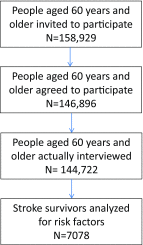Prevalence and risk factors of stroke in the elderly in Northern China: data from the National Stroke Screening Survey
- PMID: 30989368
- PMCID: PMC6517347
- DOI: 10.1007/s00415-019-09281-5
Prevalence and risk factors of stroke in the elderly in Northern China: data from the National Stroke Screening Survey
Abstract
Background: The overall global burden of stroke is considerable and increasing. In China, stroke is the leading cause of death and disability.
Methods: For this study, we used data from the National Stroke Screening Survey in 2012 and the 2010 Chinese population from sixth National Census of Populations to calculate a standardized (by age, gender, and education) stroke prevalence. Prevalence, risk factors, and management of stroke were compared by gender, age, and site.
Findings: The standardized prevalence rate of survival stroke patients in study population aged 60 and older was 4.94% in total. Hypertension was the most prevalent risk factor for stroke. Compared to men, women were more likely to have diabetes, obesity, elevated low-density lipoprotein cholesterol (LDL-C), and atrial fibrillation (P < 0.05). Men were far more likely to drink and smoke than women (P < 0.05). The rates of diabetes and atrial fibrillation were substantially higher in urban than those in rural stroke survivors (P < 0.05). Rural stroke survivors exhibited higher rates of smoking and alcohol consumption than urban stroke survivors (P < 0.05).
Interpretation: The stroke prevalence in China is in line with median worldwide stroke prevalence. Traditional risk factors remain highly prevalent in stroke survivors, among which hypertension was the most common. Stroke prevalence rates and risk factors varied by age, sex, and sociogeological factors.
Keywords: Elderly; Prevalence; Risk factors; Stroke.
Conflict of interest statement
Conflicts of interest
The authors have no conflicts of interest to declare.
Ethical standards
The study protocol was approved by the Ethics committee of Nation Project Office of Stroke Prevention and Control of Ministry of Health (Beijing, China).
Informed consent
Subjects have given their written informed consent. The study protocol has been approved by the research institute’s committee on human research.
Figures



Similar articles
-
China Stroke Statistics 2019: A Report From the National Center for Healthcare Quality Management in Neurological Diseases, China National Clinical Research Center for Neurological Diseases, the Chinese Stroke Association, National Center for Chronic and Non-communicable Disease Control and Prevention, Chinese Center for Disease Control and Prevention and Institute for Global Neuroscience and Stroke Collaborations.Stroke Vasc Neurol. 2020 Sep;5(3):211-239. doi: 10.1136/svn-2020-000457. Epub 2020 Aug 21. Stroke Vasc Neurol. 2020. PMID: 32826385 Free PMC article.
-
Prevalence, Incidence, and Mortality of Stroke in China: Results from a Nationwide Population-Based Survey of 480 687 Adults.Circulation. 2017 Feb 21;135(8):759-771. doi: 10.1161/CIRCULATIONAHA.116.025250. Epub 2017 Jan 4. Circulation. 2017. PMID: 28052979
-
Prevalence and risk factors for dyslipidemia among adults in rural and urban China: findings from the China National Stroke Screening and prevention project (CNSSPP).BMC Public Health. 2019 Nov 11;19(1):1500. doi: 10.1186/s12889-019-7827-5. BMC Public Health. 2019. PMID: 31711454 Free PMC article.
-
Prognostic interactions between cardiovascular risk factors.Dan Med J. 2014 Jul;61(7):B4892. Dan Med J. 2014. PMID: 25123126 Review.
-
China stroke surveillance report 2021.Mil Med Res. 2023 Jul 19;10(1):33. doi: 10.1186/s40779-023-00463-x. Mil Med Res. 2023. PMID: 37468952 Free PMC article. Review.
Cited by
-
A survey on the safety of the SARS-CoV-2 vaccine among a population with stroke risk in China.Front Med (Lausanne). 2022 Sep 21;9:859682. doi: 10.3389/fmed.2022.859682. eCollection 2022. Front Med (Lausanne). 2022. PMID: 36213663 Free PMC article.
-
Association between dietary patterns and stroke in patients with type 2 diabetes mellitus in China: a propensity score-matched analysis.Public Health Nutr. 2022 Aug;25(8):2188-2196. doi: 10.1017/S1368980022000763. Epub 2022 Mar 31. Public Health Nutr. 2022. PMID: 35356874 Free PMC article.
-
Stroke Risk Prediction with Machine Learning Techniques.Sensors (Basel). 2022 Jun 21;22(13):4670. doi: 10.3390/s22134670. Sensors (Basel). 2022. PMID: 35808172 Free PMC article.
-
Relationship Between Dietary Knowledge, Socioeconomic Status, and Stroke Among Adults Involved in the 2015 China Health and Nutrition Survey.Front Nutr. 2021 Sep 27;8:728641. doi: 10.3389/fnut.2021.728641. eCollection 2021. Front Nutr. 2021. PMID: 34646851 Free PMC article.
-
Prevalence and risk factors of stroke in a rural area of northern China: a 10-year comparative study.Aging Clin Exp Res. 2022 May;34(5):1055-1063. doi: 10.1007/s40520-021-02028-1. Epub 2021 Dec 2. Aging Clin Exp Res. 2022. PMID: 34855152
References
-
- Bonita RMS, Truelsen T, Bogousslavsky J, Toole J, Yatsu F. The global stroke initiative. Lancet Neurol. 2004;3(7):391–393. - PubMed
-
- Feigin VL, Forouzanfar MH, Krishnamurthi R, Mensah GA, Connor M, Bennett DA, Moran AE, Sacco RL, Anderson L, Truelsen T, O’Donnell M, Venketasubramanian N, Barker-Collo S, Lawes CM, Wang W, Shinohara Y, Witt E, Ezzati M, Naghavi M, Murray C. Global and regional burden of stroke during 1990–2010: findings from the Global Burden of Disease Study 2010. Lancet. 2014;383(9913):245–254. - PMC - PubMed
-
- Bo Norrving BK. The global burden of stroke and need for a continuum of care. Neurology. 2013;80(Suppl 2):S5–S12. - PubMed
-
- Kim JS. Stroke in Asia: a global disaster. Int J Stroke. 2014;9(7):856–857. - PubMed
-
- Qian Jia L-PL, Yong-Jun, Wang Stroke in China. Clin Exp Pharmacol Physiol. 2010;37:259–264. - PubMed
MeSH terms
LinkOut - more resources
Full Text Sources
Medical

